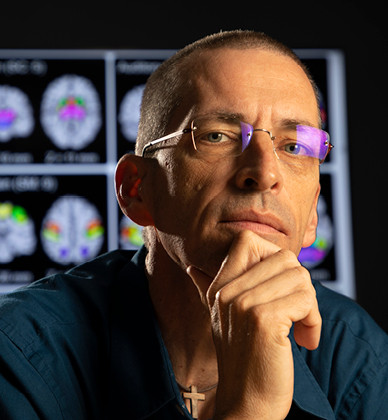Vince Calhoun, Ph.D.
Neuroscience and Neuroinformatics
Georgia State University
Emory University
Georgia Institute of Technology
Recruited: 2019
The human brain remains one of our world’s most complex mysteries. As medical imaging technology advances, scientists are devising new ways to examine this stunning and powerful organ.
Vince Calhoun is at the forefront of these efforts. A leading expert in brain imaging and analysis, Calhoun develops techniques that enable brain researchers to make the most of the massive amount of information about the brain now available to them.
Scientists can use a number of imaging technologies to examine the brain’s function: electroencephalography (EEG), functional magnetic resonance imaging (fMRI), diffusion tensor imaging (DTI) and others. Each reveals its own secrets. But these techniques also take time and expertise to master, and most brain researchers only work with one, granting them access to just one piece of the puzzle.
Calhoun’s work focuses on integrating and overlaying complementary information from multiple data sets in order to better understand the big picture. This field is called data fusion.
For example, consider fMRI versus EEG. fMRI allows researchers to observe changes in blood oxygenation as neurons fire, offering a spatially detailed image of the brain in motion. But there can be a slight delay between the neuron firing and the change in blood flow, making the exact timing difficult to pin down. On the other hand, EEG, which measures electrical signals in the scalp, shows neurons firing down to the millisecond. But because the measurement is taken by periodically spaced electrodes, spatial accuracy is poor.
Another example: combining imaging and genomic data, which provide complementary information about environmental and genetic effects.
Calhoun’s team takes two data sets like these and mathematically combines them. Using machine learning techniques and developing algorithms to link and unify data sets, they can reveal insights that neither data set could show on its own. The team’s algorithms are widely used by other brain researchers to inform their own work.
Calhoun’s lab is also applying these techniques to learn more about brain function in all kinds of conditions – autism, Alzheimer’s, depression and many others. The approach enables them to isolate specific features and functions that distinguish the brain of someone with schizophrenia, for example, from someone with typical brain function.
Along with developing algorithms and mathematical techniques to extract meaning from large data sets, Calhoun has also developed groundbreaking software and tools for managing, organizing and sharing the data.
One such tool is the Collaborative Informatics and Neuroimaging Suite (COINS), which offers an easy way for researchers to centralize all their brain imaging data in one place, with automatic archival and processing.
Another is the COINS toolkit for anonymous computation (COINSTAC), which enables researchers to share access to data for analysis without sharing the data itself. That way, more scientists can delve into broad data sets for questions to their specific areas of inquiry without compromising access to any sensitive information.
Calhoun also developed a number of analysis software tools, including the group ICA of fMRI toolbox (GIFT) and the fusion ICA toolbox (FIT). His lab shares these tools freely to help advance learning in the field.
Calhoun is the first GRA Eminent Scholar to receive a triple appointment, with positions at Georgia State, Georgia Tech and Emory. He serves as the founding director of Georgia State’s Center for Translational Research in Neuroimaging and Data Science (TReNDS), a research enterprise supported by all three institutions.
Research
RESEARCH
- Data-driven analysis of brain imaging data
- Data fusion of multimodal imaging approaches
- Methods and software for quantitative analysis of brain data
- Neuroinformatics tools and applications
- Brain biomarkers of health and disease
Straight from the Scholar
“I saw an opportunity here in Georgia, in that there is considerable interest in connecting data across investigators. I have already talked to many individuals who want to do more with their data, find easier ways to have it analyzed quickly and use cutting-edge approaches to uncover the mysteries within. Everyone is excited about putting Atlanta on the map with these large-scale brain imaging studies.”

